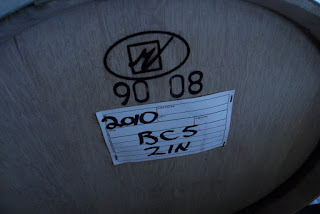The day of my visit, our goal was to blend 150 barrels of 2010 vintage wine into the 2010 Black Chicken. The barrels had already been taken down from the stacks and spread out on the winery floor on 2x2 racks. Our first job was to taste each barrel, rinsing the thief (pipette used to draw out a wine sample) between barrels using grain alcohol, one of the best sanitizers available in a winery.
One single bad barrel could ruin the whole lot! At stake is the livelihood of 15 different local grape-growing families whose grapes are represented in those barrels. We were looking for barrels that either were obviously bad (tasted like vinegar or sauerkraut or gym socks) or those that just didn't taste "right". The latter is very subtle. It could be that the aromas or wine taste flat, just not as good as they should. For each barrel, we took note of the barrel maker, year the barrel was made, vineyard source of grapes and how that barrel tasted.
I learned that in a true blend, complexity comes from not only choosing different varietal grapes from different vineyards but also mixing barrels from different makers and years. The oldest barrels on the floor dated back to 2002, the newest ones were from 2010, with the vast majority on the neutral older side (~80% old neutral wood). I started noticing the different barrel flavor profiles. I took note that I particularly loved the aromas & flavors coming from old Francois Frères barrels and from younger barrels of a brand that looked like "MV" (but later learned was "MU" for Marieu, pic of 2008 barrel below).
Our approach to blending was to separate the entire lot into 3 groups, each representing a different "terroir" and therefore different flavor profile. Group 1 was the field blends which almost by definition come from old vines. Group 2 was old vine Zinfandel from the original Aldo's vineyard. Group 3 included Zinfandel, Primitivo, and Petite Sirah from the "home ranch" in Oak Knoll District. For barrels in each group, we were tasting for "unique expression of terroir". We representatively sampled from each group, then the "all-in" all 3 groups together. From there, we tried altering more/less of a particular group. To simulate adding 1 barrel from a new (to Robert Biale) Mt. Veeder Zin vineyard we had to go down to just droplets for our 50ml sample.
Steve Hall, winemaker at Robert Biale



